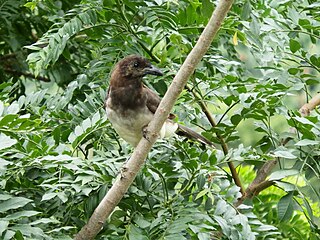
The brown jay is a large jay native to North and Central America.
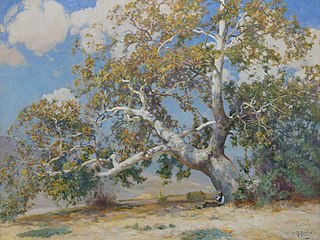
Platanus racemosa is a species of plane tree known by several common names, including California sycamore, western sycamore, California plane tree, and in North American Spanish aliso. Platanus racemosa is native to California and Baja California, where it grows in riparian areas, canyons, floodplains, at springs and seeps, and along streams and rivers in several types of habitats. It can be found as far north as Tehama and Humboldt counties.
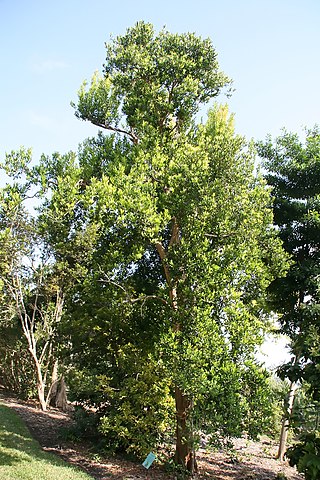
Pimenta racemosa is a species of plant in the myrtle family (Myrtaceae) that is native to the Caribbean region. Common names include West Indian bay tree, bay rum tree, and ciliment.

Caulerpa racemosa is a species of edible green alga, a seaweed in the family Caulerpaceae. It is commonly known as sea grapes and is found in many areas of shallow sea around the world. Despite the name, it is not related to grapes. There are a number of different forms and varieties, and one that appeared in the Mediterranean Sea in 1990, which is giving cause for concern as an invasive species.
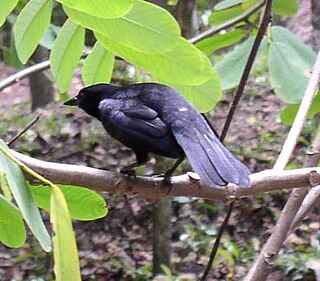
The melodious blackbird is a New World tropical bird.

Ficus racemosa, the cluster fig, red river fig or gular, is a species of plant in the family Moraceae. It is native to Australia and tropical Asia. It is a fast-growing plant with large, very rough leaves, usually attaining the size of a large shrub, although older specimens can grow quite large and gnarled. It is unusual in that its figs grow on or close to the tree trunk, termed cauliflory.

The buff-throated saltator is a seed-eating bird in the tanager family Thraupidae. It breeds from southeastern Mexico to western Ecuador and northeastern Brazil.
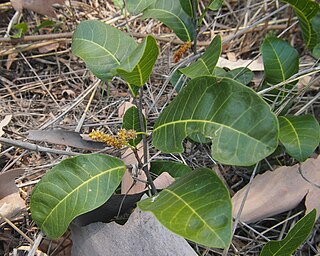
Trophis is a genus in the plant family Moraceae which includes about nine species, six of which are Neotropical and three which are Palaeotropical. It is dioecious, with male and female flowers borne on separate plants.

The golden-hooded tanager is a medium-sized passerine bird. This tanager is a resident breeder from southern Mexico south to western Ecuador.
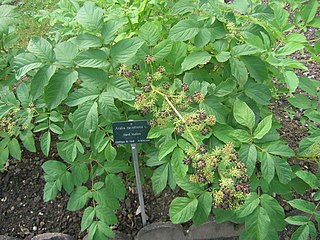
Aralia racemosa, with common names American spikenard, small spikenard, Indian root, spice berry, spignet, life-of-man, petty morel, is an ornamental plant in the family Araliaceae native to the United States and Canada. It is a herbaceous plant, about 1 to 2 m tall, which grows in shady areas. Its native range includes most of the eastern United States.
The Field Elm cultivar Ulmus minor 'Cucullata', the Hooded elm, was listed by Loddiges of Hackney, London, in their catalogue of 1823 as Ulmus campestris cucullata, and later by Loudon in Arboretum et Fruticetum Britannicum (1838), as U. campestris var. cucullata.
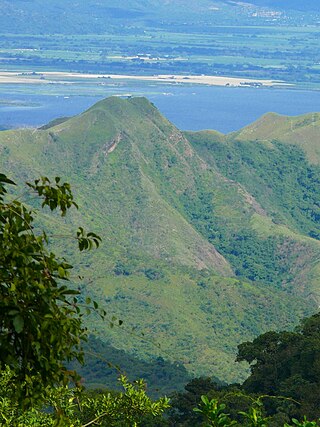
The Cordillera de la Costa montane forests is a montane ecoregion of the tropical and subtropical moist broadleaf forests biome, in the Venezuelan Coastal Range on the Caribbean Sea in northern Venezuela.

Sambucus racemosa is a species of elderberry known by the common names red elderberry and red-berried elder.

Moreae is a tribe within the plant family Moraceae. It includes 6–10 genera and 70–80 species, including Morus, the genus that includes the mulberries, and Maclura, the genus that includes the Osage orange.

Malaisia scandens, the burny vine or crow ash, is a species of large woody vines, constituting part of the fig plant family. They grow naturally in rainforests in Australia and Malesia. It is the only species in the genus Malaisia.
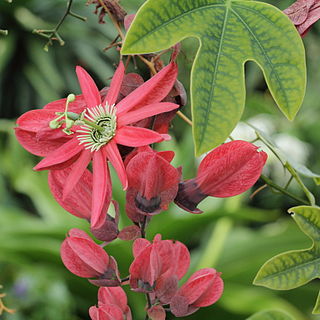
Passiflora racemosa, the red passion flower, is a species of flowering plant in the family Passifloraceae, native to Brazil. It is an evergreen climber growing to 5 m (16 ft), with simple or 3-lobed leaves to 10 cm (4 in) long, and vivid red flowers borne in summer. The flowers are 12 cm (5 in) in diameter, with purple and white coronas. They are followed by oblong green fruits.

Lumnitzera racemosa, commonly known as the white-flowered black mangrove, is a species of mangrove in the family Combretaceae. It is found on the eastern coast of Africa and other places in the western Indo-Pacific region. It has one accepted variety from the noniminate species, Lumnitzera racemosa var. lutea (Gaudich.) Exell.
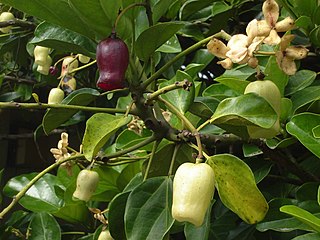
Atuna excelsa subsp. racemosa, synonym Atuna racemosa, is a tree in the family Chrysobalanaceae. The epithet racemosa is from the Latin meaning "clustered", referring to the inflorescence. The tree is widely known as tabon-tabon in the Philippines, where the fruits have been traditionally used for the preparation of kinilaw for almost a thousand years.

The Sierra Madre de Chiapas moist forests is a tropical moist broadleaf forest ecoregion in southern Mexico and southern Guatemala, extending into the northwestern corner of El Salvador.

Coffea racemosa, also known as racemosa coffee and Inhambane coffee, is a species of flowering plant in the family Rubiaceae. It has naturally low levels of caffeine, less than half of that found in Coffea arabica, and a quarter of that in Robusta coffee.



















